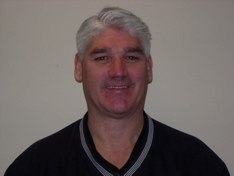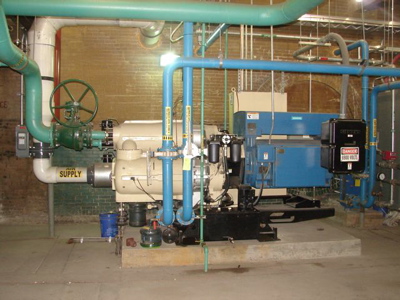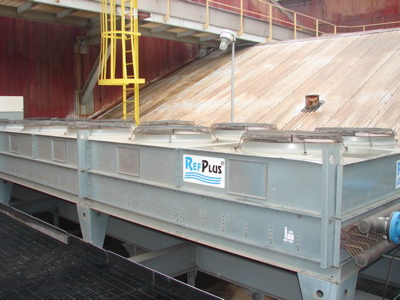 |
|
|---|---|
| Where: | Eastern United States |
| Industry: | Steel |
| Issues: | High Maintenance and Rental Costs |
| Audit Type: |
Supply & Demand Side |
| System Assessment Win/Win Results* | |
|---|---|
| Reduction in Compressed Air Use: | 3,200 scfm |
| Annual Energy Savings: | $135,000 |
| Annual Cooling-Water Savings ($): | $500,000 |
| Annual Cooling-Water Savings (gls): | 154 million gallons |
| Annual Rental Cost Reduction: | $500,000 |
*Annual energy consumption
The Steel Mill
This major mill complex upgraded their compressed air system and thereby eliminated \$500,000 in annual rental compressor costs, reduced annual cooling-water costs by \$500,000, and reduced electrical energy costs by \$135,000 per year.
The company produces flat-rolled carbon, stainless and electrical steel products, as well as carbon and stainless tubular steel products, for automotive, appliance, construction and manufacturing markets.
The company's steel operations consist of numerous steelmaking and finishing plants that produce flat-rolled carbon steels, including premium quality coated, cold-rolled and hot-rolled products, and specialty stainless and electrical steels that are sold in slab, hot band, and sheet and strip form. This company operates the first steel plant in the United States to receive ISO 14001 environmental certification.
This system assessment case study was done at a major mill complex, situated on 1,300 acres with 3.5 million square feet of buildings. The mill produces stainless and electrical steel. Melting takes place in three electric arc furnaces that feed an argon-oxygen decarburization unit for refining molten metal. These units feed two double-strand continuous casters. The complex also includes a hot rolling mill, annealing and pickling units and two fully automated tandem cold rolling mills. The mill also has various intermediate and finishing operations for both stainless and electrical steels.
The Compressed Air System
Since the plants original construction and up to 1992, virtually all the compressed air was supplied by as many as sixteen (16) water-cooled, double-acting, reciprocating air compressors. At the time of the plant construction, reciprocating-technology was the only industrial compressor technology available.
While these compressors were efficient and provided many years of reliable service, it became apparent that the system needed to be upgraded.
The compressors used “once thru” city water for cooling and had a large impact on the plants total water cost. The combined water-cooling requirement was as much as 154 million gallons/ year.
In addition, these compressors had many wearing parts including valves, un-loaders, packing, rings etc. The man hours to operate and maintain these compressors increased with every year of age.
Also, the compression cylinders were continuously injected with lubricant that eventually made it into the plant piping system. This created potential environment issues as well as quality issues. The total consumption of oil exceeded 1500 gallons annually.

Chuck Gerbe, Vice President, Total Equipment Company
Compressed Air System Upgrade Objectives and Strategy
The Total Equipment Company was invited to participate in an assessment of the “Main Plant” and offer a long-term solution to address the mills’ needs. The Main Plant is the original and primary facility that uses the greatest amount of compressed air. The melt shop and caster were to be addressed separately.
The comprehensive system assessment included an analysis of supply-side system components and measuring the demand profiles of key end users of compressed air. Total Equipment Company interviewed personnel at the mill as well and was able to create a summary of objectives with strategy recommendations.
The system upgrade objectives were summarized as follows:
1. Reduce maintenance and energy costs.
2. Reduce/eliminate water costs.
3. Reduce environmental impact of oil.
4. Reduce/eliminate rental compressor costs approaching \$500k/year.
5. Improve reliability/quality of compressed air.
6. Reduce parts inventory requirements.
7. Improve diagnostic/predictive measurements for maintenance
The strategy devised to meet the objectives was:
1. Switch to centrifugal compressors
2. Install closed loop cooling systems
3. Install compressed air dryers
4. Install blowers for low-pressure air users in the mill
Centrifugal Air Compressors
The steel mill installed two (2) 800hp and one (1) 700 hp compressor to displace all the reciprocating compressors. Oil-free centrifugal Centac® compressors were chosen. While different ratings were used, the primary spare parts (bearings, seals, pinions, filters) remained the same.
Centrifugal compressor technology is very simple and uses only a few moving parts (bull-gear, pinion, impeller). Using advanced hydro-dynamic bearing technology assures many years of reliable service.
Centrifugal compressors are oil-free and completely eliminated the oil consumption and carryover problem. Oil is now only used in a sealed environment to lubricate the bearings and gears.

Ingersoll Rand Centac® 800hp 3 stage Oil Free Centrifugal Compressor
Closed Loop Coolers
Each centrifugal air compressor was connected to a closed loop (non-evaporative) cooling system. In order to meet the cooling needs during high temperature summer days, a plate & frame supplemental cooler was employed. This cooler uses a very small amount of city water to provide supplemental cooling when the temperature exceeded 80 F. Based on ASHRAE standards this was predicted to be less than 100 hours/year.
Capital appropriations estimated the water savings to be over 154 million gallons per year at a savings of over \$500,000 per year.

Closed Loop Non Evaporative Cooler
Closed Loop Dual Pump Station & Controller
Dryers
Each of the three (3) primary plant air compressors were installed with air- cooled refrigerated compressed air dryers. These dryer were capable of reducing the dew point of the compressed air down to 35 degrees F. This eliminated as much as 1500 gallons per day of water that otherwise would have entered the plant piping system.

Ingersoll Rand Variable Capacity Refrigerated Dryer & Receiver
Blowers
The steel mill had previously used 100 psig compressed air for many low-pressure applications (air wipes, blow-offs, etc). It was determined that the plant could reduce their compressed air system energy consumption by as much as 596 KW by switching these process over to low-pressure blowers, without any sacrifice to process or quality.
Verification of Results
After the compressed air system had been upgraded and some time had passed, Total Equipment Company returned to do a post-audit verfication of results. The good news was that all of the original goals, of the steel mill, were met or exceeded.
1. Reduce maintenance costs.
a. Parts and labor costs for maintenance and operations were significantly reduced.
b. Capital appropriations estimate of \$150,000 per year savings was exceeded.
2. Reduce energy costs.
a. Air compressors totaling 800 hp were removed from the system by introducing low-pressure blowers.
b. Annual energy savings of over \$135,000/year.
3. Reduce/eliminate water costs
a. Water consumption was reduced by 154 million gallons per year (a reduction of 98%).
b. Water costs were reduced by approximately \$475,000/year.
4. Reduce environmental impact.
a. Oil carryover eliminated.
5. Improve reliability and air quality
a. Compressor uptime has exceeded 99.99%
b. Air is now oil free and dry.
c. Annual rental compressor costs of \$500,000 were eliminated
6. Reduce parts inventory requirements.
a. Single set of spares supports all three (3) air compressors.
7. Improve diagnostic/predictive measurements for maintenance
a. Each compressor has continuous advanced temperature, pressure, and vibration measurement.
Future Plans
Long-term, additional goals for this compressed air system include adding flow meters for departmental measurement of compressed usage. This will help the steel mill assess the compressed air costs of each department. The goal is to have each department start and maintain an on-going assessment of their compressed air practices and further reduce costs. In addition, the mill seeks to “link” all three (3) Centac units for additional energy optimization.
The Maintenance Building still uses two (2) small, Ingersoll Rand, water-cooled, double-acting, reciprocating compressors. The Total Equipment Company has recently been contracted to conduct an Ingersoll Rand “Intellisurvey” on this system to determine potential savings on this system. The air demand in this system is much lower than the main plant and it is anticipated that a high efficiency, variable speed, air cooled, Ingersoll Rand Nirvana class compressor will be the solution for this system.
For more information please contact Chuck Gerbe, Total Equipment Company, www.totalequipment.com





